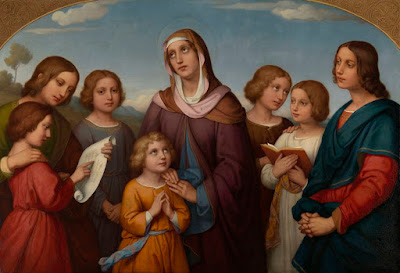You can read about the past devotions at the following posts:
- 2006 Saint for the Year Devotion
- 2007 Saint for the Year Devotion
- 2008 Saint for the Year Devotion
- 2010 Saint for the Year Devotion
- 2011 Saint for the Year Devotion
- 2012 Saint for the Year Devotion
- 2013 Saint for the Year Devotion
- 2014 Saint for the Year Devotion
- 2015 Saint for the Year Devotion
- 2016 Saint for the Year Devotion
- 2017 Saint for the Year Devotion
- 2018 Saint for the Year Devotion
- 2019 Saint for the Year Devotion
- 2020 Saint for the Year Devotion
When will the saints be drawn? This year I will start the drawing of saints in the morning of the Feast of the Circumcision and the Octave Day of Christmas (i.e. January 1st). Drawings will occur as the Litany of Saints are recited. That means results will likely be posted in the late afternoon (US Central Time) on Thursday, January 1, 2021. This will be the only drawing this year.
How do I enter? Just add the names of everyone (you and your family) that you want to be included in the drawing in the comment box below. DO NOT also email them to me. Emailed entries will not be accepted. Please leave all entries in the comment box to this post. If you get the message, "Your comment will be visible after approval" then your submission was successful. It will be viewable after I approve it.
“There is a custom among us of drawing by lot, on New Year's Day, special Patrons for ourselves for the whole year. In the morning during meditation, there arose within me a secret desire that the Eucharistic Jesus be my special Patron for this year also, as in the past. But, hiding this desire from my Beloved, I spoke to Him about everything else but that. When we came to refectory for breakfast, we blessed ourselves and began drawing our patrons. When I approached the holy cards on which the names of the patrons were written, without hesitation I took one, but I didn't read the name immediately as I wanted to mortify myself for a few minutes. Suddenly, I heard a voice in my soul: ‘I am your patron. Read.’ I looked at once at the inscription and read, ‘Patron for the Year 1935 - the Most Blessed Eucharist.’ My heart leapt with joy, and I slipped quietly away from the sisters and went for a short visit before the Blessed Sacrament, where I poured out my heart. But Jesus sweetly admonished me that I should be at that moment together with the sisters. I went immediately in obedience to the rule.”Excerpt from Divine Mercy in My Soul, the Diary of St. Faustina"
The practice was also done prior in various monasteries - one such instance was the Abbey of Maredsous, Belgium, which distributed the name of a saint to each monk so the recipient could study, pray to, and befriend the saint during the liturgical year.
Over the years, I've heard from many people about the great connection they have to their special patrons. Here is one of those stories from the past:
I have Saints Marcus and Marcellianus ... they are twin brothers who were sent to prison before their death. St. Sebastian visited them continually in prison and helped keep their faith alive. They are buried near St. Felix and are specifically honored in Spain. OK now ... here are a couple of immediate ironies in regard to these saints ... I have a SPECIAL place in my heart for twins! As a child, I LOVED reading the story about St. Sebastian. I had a children's book of saints and I think I wore out the pages on St. Sebastian! Felix is my grandfather's name! Silvia, our exchange student, is from Spain! I am so excited to have these two saints to walk through 2006 with me! I'm looking forward as to where and how they will intercede for me.Please pass this message on through your blogs and/or email distribution lists, letting all of the Catholic Blogsphere have the chance to participate.
If you would like to participate, please leave your name below in the comment box. If you wish to remain anonymous, please leave your initials instead of your name. Anonymous requests without names or initials will NOT be part of the drawing. Do not add the same request more than once. If you get the message, "Your comment will be visible after approval" then your submission was successful. It will be viewable after I approve it.
Note: DO NOT email me your entries. Emailed entries will not be accepted - no exceptions. Leave all submissions here in the comments box to this blog post. Your name and comment will appear shortly after you make it. If you do not see it, then your comment did NOT go through. So, comment below and pass this message on throughout the entire Catholic Blogsphere!
Donate to Participate
If you find this devotion helpful and would like to support A Catholic Life in the next year, please submit a donation. This devotion takes a significant amount of time to facilitate as I cut hundreds of saints' names on paper to draw them, and I pull them out after a prayer for each and every name submitted in the comments box. If you are especially listing more than 3 names, please make a donation.




















